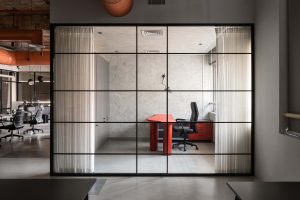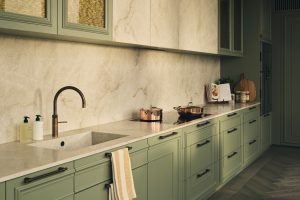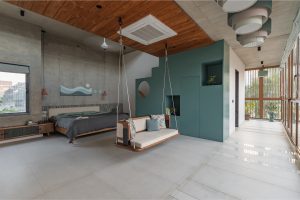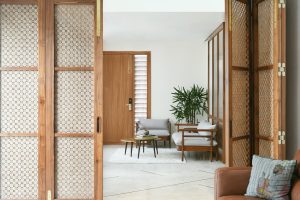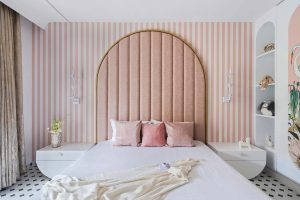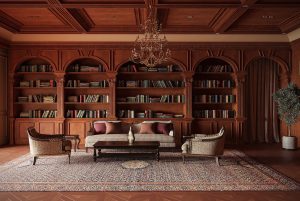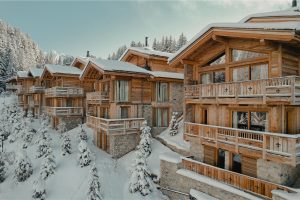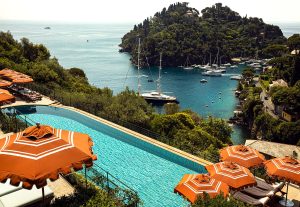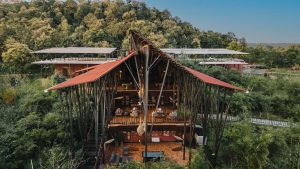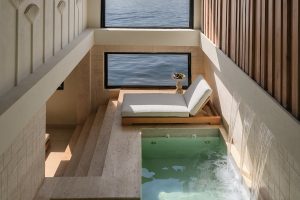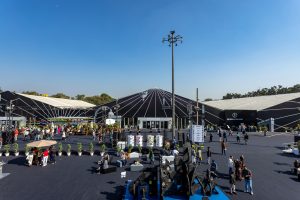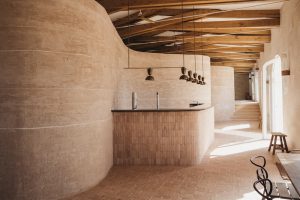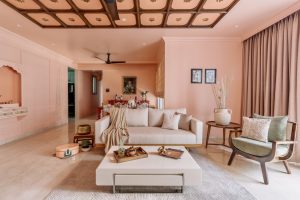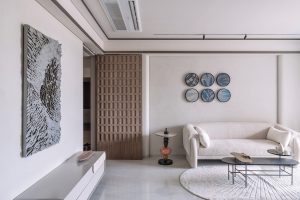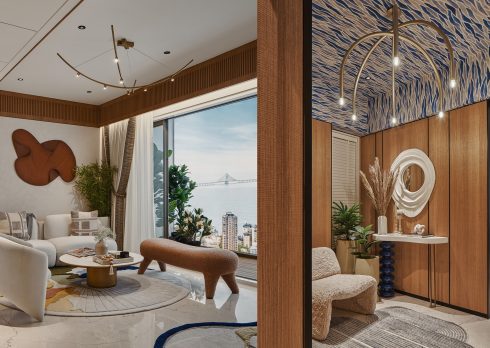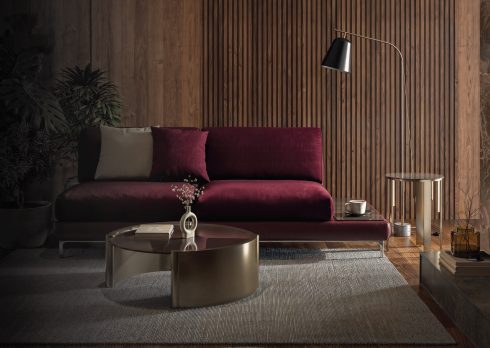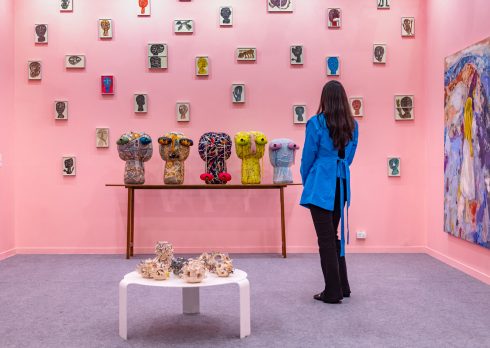India’s Most Exclusive Social Clubs: From Neoclassical Tollygunge To Design Forward Polo Palladio Jaipur
Private clubs in India, once exclusive bastions of post-colonial privilege, are evolving to meet the needs of a new, diverse generation. This article explores how four legacy establishments merge golden-age opulence with modern sensibilities through thoughtful design interventions.
- 11 Jul '24
- 12:41 pm by Virender Singh
Hedonistic, sumptuous and rooted in nostalgia, the private clubs and gymkhanas of India have been shrouded in mystery for too long. These swanky pleasure palaces have been a stamping ground for competitive sports, cultural gatherings and leisure seekers for centuries. However the Midas touch of contemporary design interventions, restorative in nature, but sometimes unapologetically ornamental has helped these establishments to linger on — especially in the fugue of post-pandemic hospitality. DP compared notes with four legacy clubs to learn how they have stayed afloat in the mainstream consciousness, without losing their neo-classical grandeur.
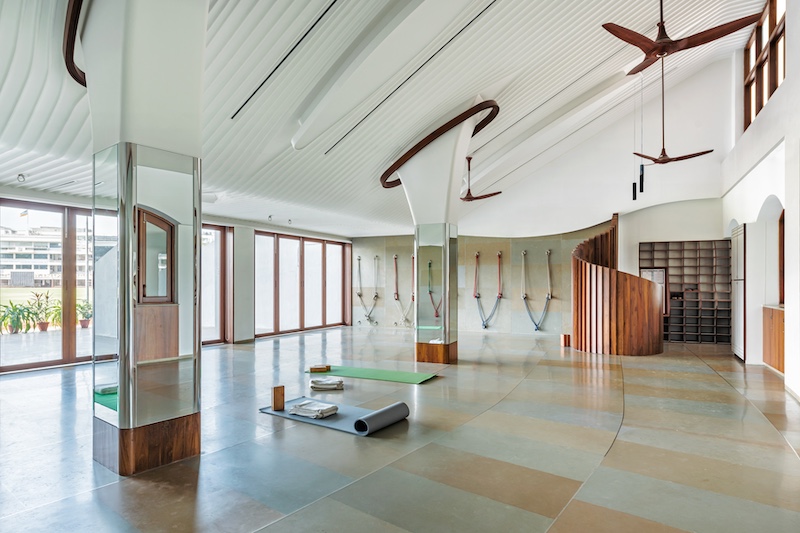
Cricket Club Of India — Keeping Context In Focus
For the architectural designer Pravir Sethi, Mumbai’s Cricket Club of India (CCI) is not just a restoration project but an indelible, sun-drenched chapter from his boyhood. “Subconsciously, you are designing for a place that you grew up running around, that has been a second home,” Sethi observes. “I’ve been a member since the age of 18, but before that, my dad was a member and my grandad before him.” Growing up a stone’s throw away from the club, its sublime Art Deco façade, charismatic pavilions and landscaped gardens had fondly remained as a wellspring of inspiration for him.
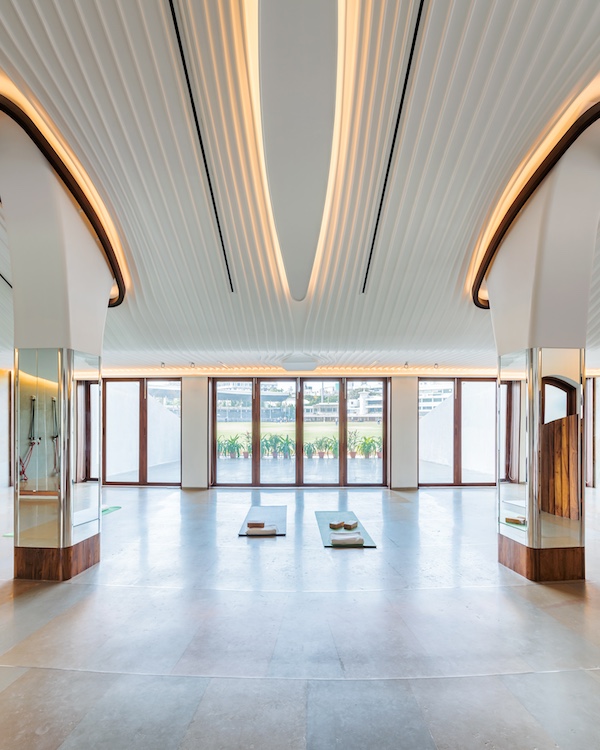
For his award-winning design lab Studio Hinge, to gain a handle on the social or historical context has always been imperative before beginning work on any new site. “You can be contemporary whilst being cognizant of the past,” he notes. “I think the thing to do is to appeal not to a sense of nostalgia, but familiarity.”
Beneath the bleachers of Brabourne Stadium, India’s first permanent sporting venue dedicated to cricket, Sethi has discreetly refurbished an Iyengar yoga studio for CCI that was long overdue for a facelift. “The overarching design element in the yoga room is the ceiling,” the principal architect elaborates. “You have these fluted POP grooves in a force-field pattern that part to accommodate the columns.”
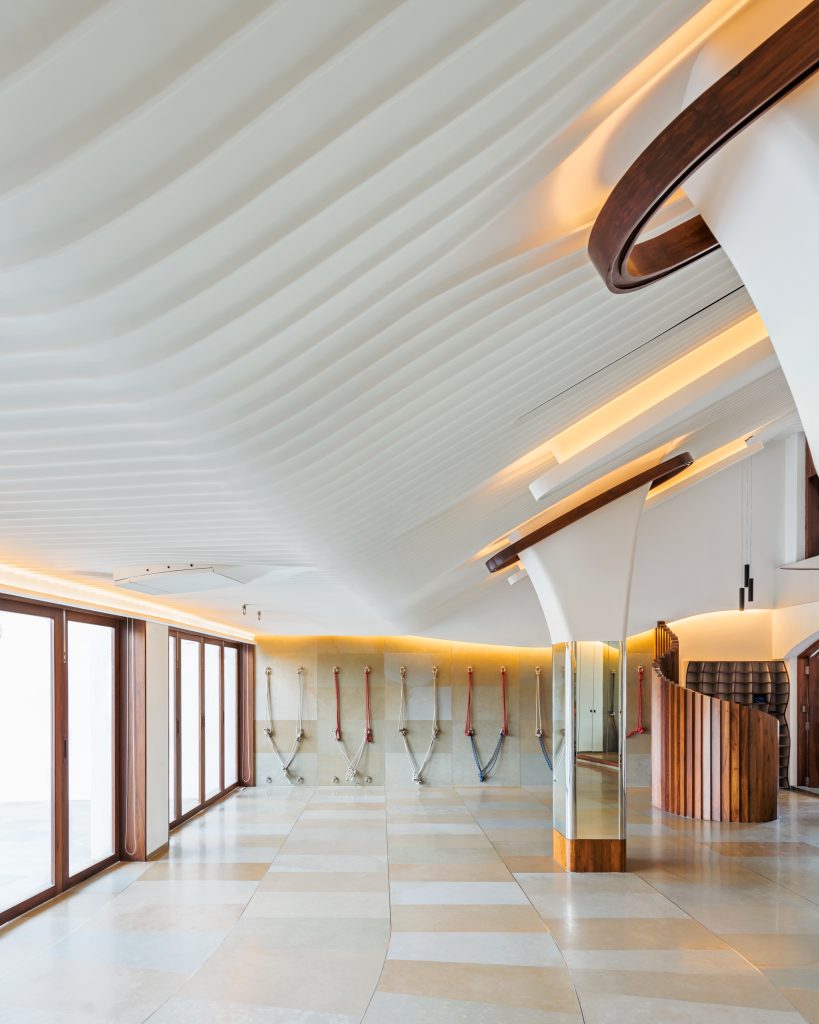
Unabashedly observant and passionate about engaging with the end users, Sethi gleaned that many people who used the studio were feeling disoriented because of the wedge-shaped geometry of the space with its non-parallel walls. With their uncanny ability to innovate, the design team at Studio Hinge deployed stainless steel inlay strips along the floor as visual markers to help the suspended yogis maintain their form. Other elements, such as the space-saving pigeonholes for footwear, the swirling timber posts of the reception pod, and the strategically placed indirect lighting to avoid straining the eyes, demonstrate that interior design and human comfort are not mutually exclusive.
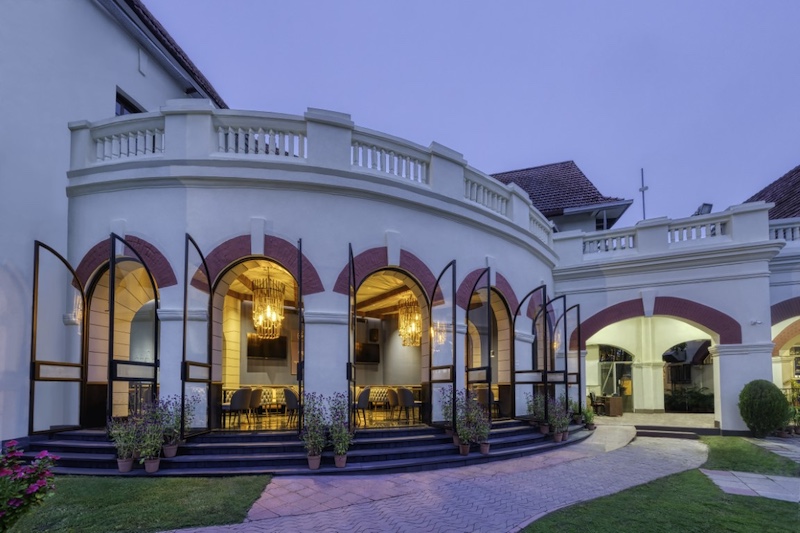
Royal Calcutta Golf Club, West Bengal — Designing From A Human Perspective
Restoring the oldest and most exclusive golf club in India seemed like quite a tall order at first to Pooja Bihani, an interior designer and principal architect of Kolkata-based Spaces & Design. “Golf is a rage in Calcutta, okay?” Bihani observes. “And that’s why a membership of this Tollygunge club or an RCGC is very precious.” Sprawling across an expanse that used to be knee-deep in paddy fields, the Royal Calcutta Golf Club (RCGC) however has successfully shed its age-old inhibitions and is now a coveted third place for trendy expats and seasoned locals. “The winter Sunday brunches here are a thing to look forward to because it is quite an address,” she confesses.
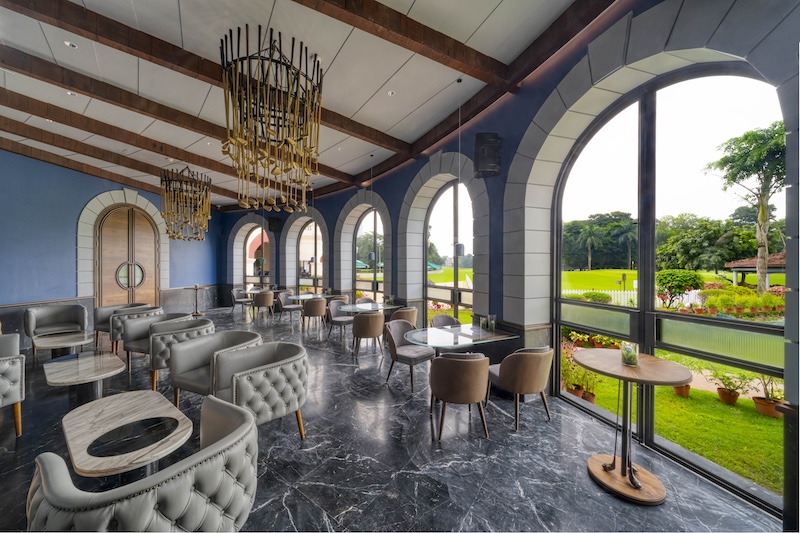
“Retrofitting the arches, joists and cornices required a careful balance of preserving the heritage elements while enhancing their proportions,” says Bihani. The Prohibition era-style, sumptuous ‘Bar at 19’, was refurbished to be an apotheosis of functionality and aesthetics. Inhabiting a curvilinear verandah with cascading steps, its formidable arches promise an animated tête-à-tête with players post-match sessions or simply a quiet luncheon with a view of the lush manicured fairway.
Initially, the challenge was to open up the space around the arches and replace built-in sofas with flexible, round tables positioned near the windows to make the most of the view and accommodate seating needs. A major consideration was also the large bar counter, a central feature with substantial requirements.
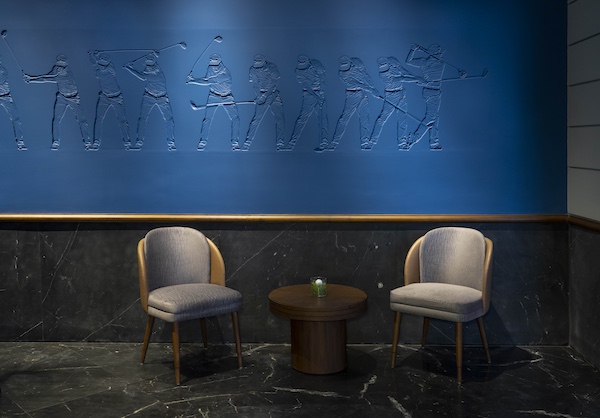
To offset the counter’s size and maintain its cutting-edge allure, Bihani incorporated a soothing shade of Pantone Classic Blue from the ironically tumultuous year of 2020. Also featured here is a blank wall adorned by a relief depicting the perfect golf swing. This heartfelt tribute is appreciated by its clientele as an endearing, positive affirmation.
“It is a reminder that you have to continuously practise your swing and not go off track,” the architect sums it up. Her studio Spaces and Design has set the benchmark for endowing a fresh purpose to heritage architecture. Established in 1829, the Royal Calcutta Golf Club holds space today as it has done for centuries for felicitating a sport that never really cherished its heyday in South Asia (unlike football or cricket). RCGC lingers on as a legendary institution in its own right, especially now that golf is no longer a mere catalyst for business negotiations or an indulgence for the crème de la crème.
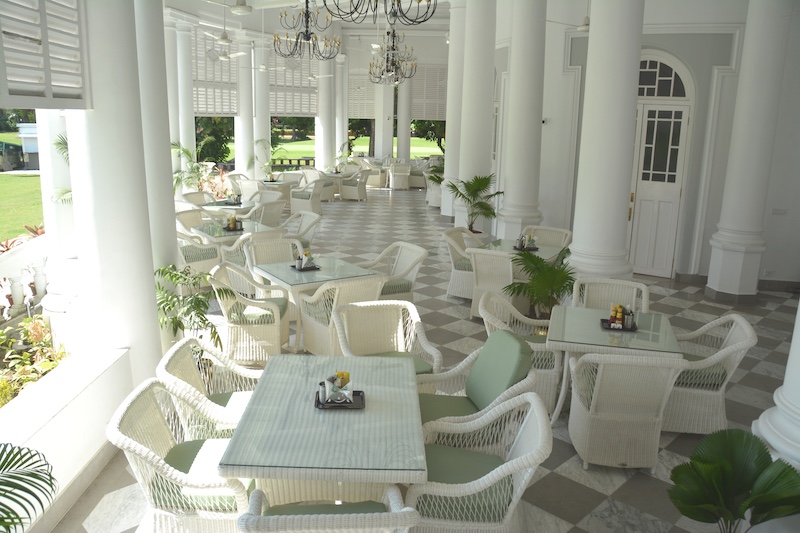
The Tollygunge Club — A Yearning For Vintage Luxury
A hop and skip away from RCGC with its undulating 18-hole golf course, state-of-the-art squash courts and incomparable equestrian facilities, the Tollygunge Club was originally modelled upon smoky, low-ceiling London coffee houses. However, this neoclassical establishment emulates a countryside respite more than anything. While the juggernaut of liveried servants, hasty puddings and white supremacy may be comfortably behind us, an acquired taste for decorum still lingers on among its old-school patronage.
The Cruickshank Bar exudes a bygone rusticity with its smooth concrete countertop, parquet floors, rich emerald-hued walls and speakeasy high barstools. But the crown jewel here is unremittingly Belvedere, a continental dining room with the graceful silhouettes of Victoria double height jhumars (chandeliers), gilt-framed artwork and an ornately vestibular shape to the room itself.
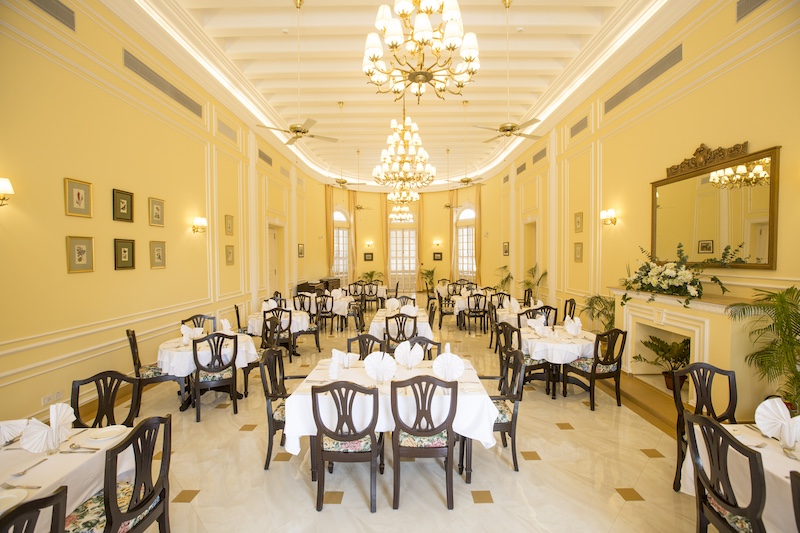
“Generations of children have grown up at Tolly,” confirms Brigadier V. Ganapathy (retired), the CEO of Tollygunge Club. “They have learnt from the multicultural environment and evolved to become individuals who are respectful and tolerant to diversity.” From weekly equestrian lessons to immersive jazz concerts, this establishment is certainly not out of tune with the cultural momentum of the modern day.
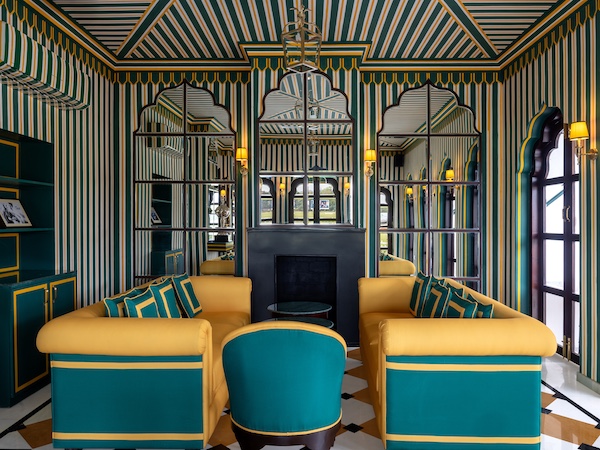
Polo Palladio Jaipur — A Unique Way Forward
“Our style, since initially opening Bar Palladio Jaipur back in 2013, has always believed in colour and pattern” remarks Marie-Anne Oudejans, the Dutch visionary who designed Polo Palladio Jaipur. “I would not call this style a maximalist, as maximalism generally believes in clash or a juxtaposition.” Doused in a heady immersion of chevron, floral geometry and royal family hand-me-downs, this latest addendum to the storied Rajasthan Polo Club unfolds like a dreamy caravanserai. Never straying far from the club’s imposing history, Oudejans was keen to introduce a series of fresco oil paintings in her visual language. “Painting is the heart of the Palladio aesthetic and we wanted this project to have something more formal, more old world,” she explains. When we talk about history it was all the memorabilia that made this project so fun and helped ground the design, giving the fantasy a character and a sense of place.”
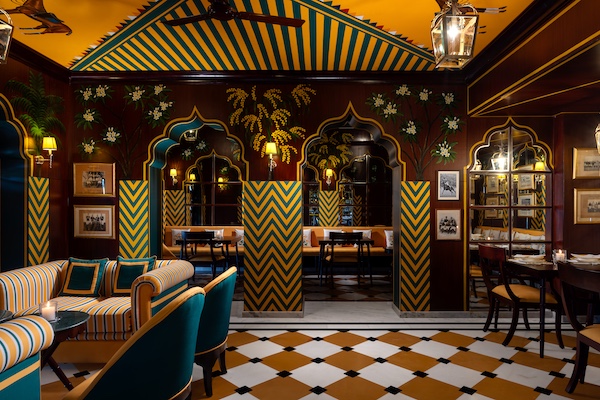
Blooming in the middle of Central Park, its layout encapsulates the clubhouse interiors, an outdoor patio, and a lush garden that surrounds it with the colour green that would become its defining feature. While yellow came about almost as an afterthought, to fulfil the need for two instantly recognisable colours, much like a sports team.
Sauntering through its damask archways adorned with bright sprays of oil-painted foliage, an uninitiated visitor might experience the psychedelia of having stepped into an elaborately composed miniature. A veritable Pandora’s Box opens up from the Maharajah’s past — disbursing old trophies and polo mallets, black and white photographs, letters from Nehru and the Queen of England — living proof that modern appreciation for curated extravagance could be a form of time travel.
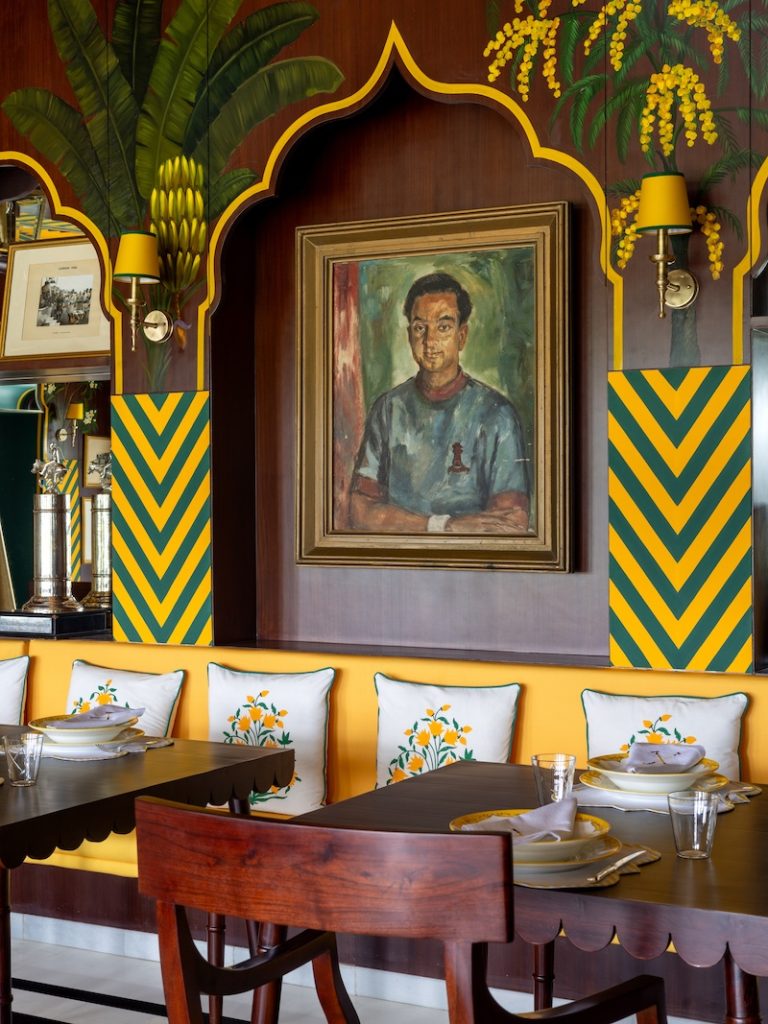
“The majority of our clientele are existing Rajasthan Polo Club Members (founded 1918) so this comprises the majority of Rajasthan’s old nobility and prominent business families,” the designer confessed. “Alongside this, as the whole world comes to Jaipur, we have guests and members from everywhere— fashion designers, jewellers, cool kids, artists, jet setters, celebrities among many others.” Polo Palladio’s intervention represents a new century for the Rajasthan Polo Club, one where the members-only clubs that were once epicurean hideaways for the affluent, are now a thriving nexus of the millennial influencers and savvy tastemakers.
Once a straitjacketed, exclusionary offshoot of the post-colonial urban milieu, social clubs in India have rediscovered a hunger to remain au courant with shifting sensibilities. Whether it be through aesthetic upgrades or curating beguiling experiences, a groundbreaking renaissance is afoot in the hospitality industry, one that has identified the significance of inclusivity towards a wider demographic. What sets their new incarnations apart is an emphasis on cultivating multi-sensorial experiences. With newer avenues for connecting over mutual interests like speakeasy bars, impromptu rock jam sessions, guest lectures on niche topics or a trivia night for the platinum club members, these amenities create a dynamic environment where people from various backgrounds can connect, learn, and unwind.

